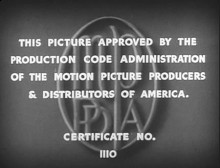
About a week ago a friend of mine argued that Hammer horror movies were considered adult fare and were “rated accordingly,” which I knew was demonstrably wrong—at least in America for the first 11 years of the studio’s heyday. Yesterday my mother forwarded me one of those annoying e-mails extolling how “great” things used to be that asserted that movies didn’t used to need ratings because they were made by “responsible people” who made sure they were suitable for “everyone.” I knew that was pretty much banana oil. These two things—along with various bouts of balderdash I’ve heard over the years—prompted me to offer this column in an attempt to set a few things straight.

Let’s start with where we are today and the ratings system of the MPAA (Motion Picture Association of America) and how we got there. The MPAA is the current incarnation of MPPDA (Motion Picture Producers and Distributors of America). The MPPDA was founded in 1922 for the express purpose of fending off the possibility of a national government board of censors. There was a great moral outcry at that time over the “excesses” of Hollywood—as much offscreen as on. It wasn’t just the content of the movies that brought this on, but the scandals of the movie industry like the murder of director William Desmond Taylor and the trial of Roscoe “Fatty” Arbuckle for the rape and murder of starlet Virginia Rappe. It didn’t matter that Arbuckle was exonerated, and the situation wasn’t helped when matinee idol Wallace Reid died of a morphine overdose in January of 1923. The idea was that Hollywood had to clean its own house or the federal government would step in.
That’s still the governing principle behind the MPAA today—to prevent the establishment of a government censor. While there have been state level censors over the years, America has never had a national movie censorship board. And this leads us to one of the biggest of all misconceptions prevalent today—the belief that movie ratings have some sort of legal weight. They don’t and they never have had. They are overseen by NATO (National Association of Theater Owners), who have been known to send operatives to find out if theaters are adhering to the MPAA ratings, but this also carries no legal meaning. It is not illegal for someone under the age of 17 to see an R or NC-17 rated movie, even though most theaters adhere to the policy. And it most certainly is not—as I have heard outraged patrons insist—a “violation of federal law,” because there is no federal law dealing with the topic.

Prior to the 1922 formation, there was no governing principle behind what could and couldn’t be in a film. Movies merely more or less conformed to the standards of the day, which—to judge by the evidence of pre-1922 movies—were pretty loose. Nudity was not unheard of and violence was common and fairly graphic—as witness the beheadings in D.W. Griffith’s Intolerance (1916). The standards supposedly established in 1922 didn’t alter things all that much. Cecil B. DeMille quickly discovered that his sex dramas with near or glimpsed nudity were still permissible—if they wore dressed up as religious spectacles. Indeed, he would take that to such extremes in 1932 with his The Sign of the Cross, that he contributed to the impending crackdown on “immorality” in no small measure.
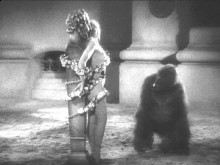
In many cases—at least until recently—the actual original content of these films was little known, because viewers were seeing later re-issue prints that had been cut to conform to later, more strict standards. When I first saw Ben Hur (1926) in college, its topless women were nowhere to be found. Similarly, the print of Sign of the Cross that can on TV when I first encountered it, the inventive atrocities inflicted on the Christians had been toned down, and the pompous, preachy prologue and epilogue that had been slapped on it 1944 was still there. (I don’t recall whether or not Claudette Colbert’s nipples and obvious lesbianism were intact, but the scenes alligators, man-eating elephants and the naked girl chained to a stake and menaced by a gorilla were not there.) In recent times, this material has been restored.
The richest period for movies that put the lie to the idea of movies made by “responsible people” that were suitable for everyone are those early talkies we refer to as “pre-code,” of which Sign of the Cross was definitely a part. The term “pre-code” means that these films were made prior to Production Code of 1934 when very strict—and enforced—rules were brought into play, largely created by the Catholic Legion of Decency. These rules would attempt to emasculate the movies for years and went largely unchallenged for 20 years.
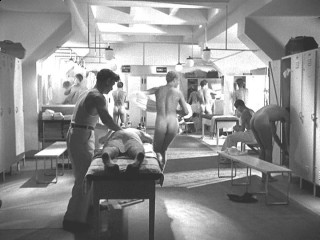
It is this code that gave rise to the myth that Clark Gable saying, “Frankly my dear, I don’t give a damn,” was the first time anyone swore on the screen. Yes, it did require a special dispensation from the code folks, but it was hardly a first. Without thinking too much about it, I can rattle a fair number of instances of pre-code swearing: Disraeli (1929), Sunnyside Up (1929), The Green Goddess (1930), Mammy (1930), The Dentist (1932), and The Old Dark House (1932). There was also a degree of nudity—as witness the bra-less girls in very sheer blouses in Flying Down to Rio (1933)—not to mention the cheese-and-beef-cake parade that is Search for Beauty (1934). The scene next to this paragraph is from that curious work. Drugs, prostitution, crime unpunished, casual sex, infidelity treated as comedy, gay subext—you name it, it’s in pre-code film.
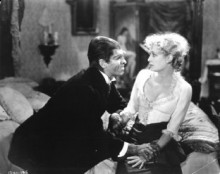
One of the worst things about the code lay in the previously mentioned practice of re-issuing popular films and cutting them to meet the new requirements. In some cases this was disastrous. Rouben Mamoulian’s Dr. Jekyll and Mr. Hyde (1932) is a classic example, being cut from 90 minutes to around 70 minutes. For years the film was suppressed by MGM, who bought it from Paramount so they could follow its screenplay for their 1941 version of the story—and so no comparison could be made. By the time that was no longer a consideration, all anyone could turn up was the shortened print—and it remained so for years. When I first saw the film, it was that print. It was also one of the biggest disappointments of my moviegoing life. It wasn’t bad, but it wasn’t brilliant. Seeing the 90 minute print was a revelation. Taking 20 minutes out of the movie had completely destroyed the pacing. It was like being dragged through a really cool museum so fast that you couldn’t really look at anything.
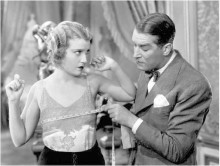
Jekyll and Hyde had a happy ending. Other films—including Mamoulian’s Love Me Tonight—haven’t been so fortunate. According to some sources, Love Me Tonight originally ran 104 minutes. Other sources, list 96 minutes. Current prints clock in at 89 minutes. Oddly, the code folks advised Paramount against re-releasing the film in the late 1930s because of all the cutting it would require, but by the late 1940s the standards had changed to a point where it was agreed a compromise could be reached. That appears to be the only version left. The original negative is gone or lost and no complete print is known to exist. (It doesn’t help that individual states—some of which did have government censor boards—had cut the film in 1932.) This is not an isolated incident.
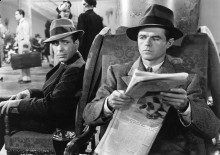
Fortunately for the post-code movies, the code office was far from infallible and could often be bamboozled. A common trick was to put something guaranteed to send the into a tizzy in a script right next to the scene you wanted to go through, working on the idea that they’d be so outraged over the deliberate affront that they’d miss the real one. According to writers and directors who dealt with the code, this often worked. It also helped that censors are not always terribly savvy or, perhaps, smart. Nothing else explains the presence of references to Sherlock Holmes’ drug use in The Hound of the Baskervilles (1939) and Sherlock Holmes and the Secret Weapon (1942), or the lesbian aspects of Dracula’s Daughter (1936) and The Seventh Victim (1944), or the white slavery ring in The Monster and the Girl (1941). And obviously, they had no clue that the word “gunsel” in John Huston’s The Maltese Falcon (1941) was underworld argot for homosexual.
As the years wore on, the restrictions relaxed—in part just because of the changes in society, but also because some filmmakers, notably Otto Preminger, chose to ignore the code altogether and release movies without an approval seal. When this didn’t prove to be quite the kiss of death at the box office the MPAA assumed it would be, they broadened the code. The interesting thing about this is it quickly disproves the fantasy of those “responsible people” making movies suitable for everyone a second time. Looking at the movies I was taken to as part of a family outing in the late 1950s and early 1960s, I am astonished to see the wide range of movies that were clearly not appropriate for children. And those Hammer horror films that were rated for adults only in Great Britain were not only “approved” in the States, they were frequently booked for kiddie matinees.

But these changes weren’t enough. When Michelangelo Antonioni’s Blow-Up (1966) was not only popular, but garnered a couple of Oscar nominations without a code seal, the groundwork for MPAA head Jack Valenti to implement his idea of ratings (based to some extent on the British approach). This was the birth of the rating system. And by November 1968, the original ratings—G, M, R, X—appeared. The M rating (for mature) was then changed to GP and finally PG, with PG-13 arriving in 1984, after the fuss over a PG rating for Indiana Jones and the Temple of Doom.
This came with its own set of problems. Thought the original G rated films covered a wide-range of titles, it quickly became a liability as code for children’s movies. The result? Filmmakers added swearing to movies to avoid the rating. The X rating was even more troublesome—in part because the rating was never trademarked. As a result, it became associated with porn and theater chains started refusing to book them, while some newspapers wouldn’t advertise them. By 1974, the rating was all but dead.

The MPAA tried to revive the rating in 1984, urging New World Pictures to accept the X rating for Ken Russell’s Crimes of Passion. According to the film’s screenwriter, Barry Sander, the MPAA saw the film as a chance to make the rating legitimate once again. But New World insisted on an R rating and the idea went nowhere. This was supposedly fixed by coming up with the NC-17 rating replacing the X. The same problems arose with theater chains and newspapers. There’s a frequent hypocrisy to this. Carmike Cinemas, for example, view themselves as “family friendly” and won’t book an NC-17 film, but they will book an unrated film and treat it as an R. About the only place you’ll see an NC-17 rating is on art titles—Almodovar’s Bad Education (2004) and Bernardo Bertolucci’s The Dreamers (2003), for example.
Neither the X, nor the NC-17 rating seem to be very clearly understood. Most people tend to think that it means the film is uncensored in an anything-goes manner. It doesn’t. Movies granted that rating are also subject to approval and demands for cuts are not unknown by any means. A film like John Cameron Mitchell’s Shortbus (2006) would not have gotten a rating of any kind from the MPAA. The only route for a complete lack of censorship is to release a film with no rating at all. And since rating aren’t a legal requirement, there’s no actual reason for it, except that it makes theater chains easier to deal with—as long as you don’t get anything harsher than an R.




Ken, it’s eerie how similar this column is to the paper I wrote for a grad school class last year. I touched on all the stuff up until 1934-35 that you mentioned (MPAA, Code, etc.) but my conclusions ended up being somewhat different.
I ended up concluding that the Production Code’s strict enforcement was inevitable due to protests like the one in Philadelphia in 1934. Further, studios were losing too much money having to deal with the idiots that ran state censor boards (NY, OH, KS, etc.). Entire reels could be cut out, thus rendering that film useless to other markets. It was good business to simply deal with Joe Breen. It was also the Depression era of course, but a combo of an all time bad economy and also film content that was off putting to middle America led to studios losing a ton of money.
However, we do agree on the biggest crime committed by post code censors, which is the cutting of classic films. Sometimes footage has been found and restored, but other times it ended up lost forever.
In the end it is astounding that Hollywood went another 34 years before finally giving up on the Code and Legion of Decency and installed the ratings system. Even then it’s amazing to watch late 60s or early 70s movies where people are getting killed and cursing is prevalent….and that movie is rated G (stuff like Chisum with John Wayne for instance).
I touched on all the stuff up until 1934-35 that you mentioned (MPAA, Code, etc.) but my conclusions ended up being somewhat different.
The basics are going to be similar. What surprises me is that most people have no knowledge of them. I really draw no conclusions, apart from the fact that it all comes down to preventing government intervention. That was clear in 1922 and it was clear in 1934. In both cases, public and religious outcry threatened to make the government step in. That’s really the basis they’ve kept themselves going on. What I wonder is how true is still is.
Even then it’s amazing to watch late 60s or early 70s movies where people are getting killed and cursing is prevalent….and that movie is rated G (stuff like Chisum with John Wayne for instance).
You could tell at the time that the ratings were peculiar and particularly slanted not to hamper studio cash cows. Others seem to have been rated on tone and the times. There’s no way the line, “Jesus Christ, I absolutely cannot play the goddamn thing,” in The Might Be Giants is really G material, but that same year CBS broadcast the Broadway revival of The Front Page — with the language intact. ABC had done a largely unexpurgated Arsenic and Old Lace in 1969.
It seems to have taken them awhile to figure out just how mature M was, too. A fair amount of nudity, especially topless women, was not uncommon in the first few years in M rated pictures.
“M” is a confusing rating. It means mature, or at least you’d think so. But apparently it was the first attempt at a PG style rating. True Grit was rated “M” in 1969 for some violence and the “Fill your hands you SOB” quote. But now that is basically a typical PG-13 film.
M” is a confusing rating. It means mature, or at least you’d think so. But apparently it was the first attempt at a PG style rating. True Grit was rated “M” in 1969 for some violence and the “Fill your hands you SOB” quote. But now that is basically a typical PG-13 film.
The rating wasn’t confusing — it clearly says “suggested for mature audiences.” The confusion comes in the definition of “mature.” There’s really no reason a film would get a PG-13 over “son of a bitch,” if that’s all it has, but I don’t recall the level of violence that clearly. Still, the MPAA has always been lenient on violence as long as it’s not gory.
In Oz we have:
G – General, for all audiences
PG – Parental Guidance is recommended
M15+ – Recommended for mature audiences, but all ages still allowed in.
MA15+ – Mature audiences, only 15s and over are allowed to purchase tickets.
R18+ – Adults only.
For some context, some films currently in cinemas:
Yogi Bear is G, despite being a film about a furry pedophile.
Gulliver’s Travels is PG.
Harry Potter 7A is M15+, as is The King’s Speech.
Black Swan and The Fighter are MA15+.
There aren’t currently any R rated films showing, but David O Russel’s THREE KINGS was R, as was HOSTEL.
Sherlock Holmes’ drug use in The Hound of the Baskervilles (1939)
I wonder how they got the past them. Did they think ‘Watson, the needle’ was Holmes asking the Doctor to fetch his knitting equipment?
The original True Grit pretty much had the same vicious “cut the fingers off and stab in the chest” scene that was in the remake, with Dennis Hopper being the victim in the cabin this time. True Grit is a bit too adult oriented a film to be a mere PG rated film, but as the Coens noted the heroine is a 14 year old girl and thus that age group should be able to see the film without it being rated R.
When I first saw the original TRUE GRIT, I remember being startled by the scene where Jeremy Slate lops off Dennis Hopper’s fingers and then stabs him in the chest before being gunned down by Wayne. As in the remake, that scene was pretty violent and would easily have lited the original out of the G range.
Harry Potter 7A is M15+, as is The King’s Speech
See, that more or less lines up as concerns Harry Potter and its PG-13, but it’s a breath of fresh air concerning The King’s Speech which here gets slapped with an R for what we might call a fu*k-load of f-words — none of which are sexual in nature. I can honestly think of no good reason for children not seeing it, and can think of several good reasons that they should be allowed to.
I wonder how they got the past them. Did they think ‘Watson, the needle’ was Holmes asking the Doctor to fetch his knitting equipment?
I figure they simply didn’t understand it — just as they didn’t get Moriarty’s “The needle to the last, eh, Holmes?” in Secret Weapon.
As in the remake, that scene was pretty violent and would easily have lited the original out of the G range.
But enough to get out of the PG range? Bear in mind that The Green Berets got a G. You would think Jim Hutton’s gory death would be enough to kill that. Perhaps there was a special barometer for John Wayne pictures.
I’ve always wondered if filmgoers did their homework earlier on with the MPAA code. How many kids went to see the original TRUE GRIT?
Ken, maybe you know this, but did EXTASY ever play in the States in the 30s? There’s a lengthy nude scene by Hedy Lamarr in that one.
I’ve always wondered if filmgoers did their homework earlier on with the MPAA code.
Considering they scarcely do it now, I see no reason to believe they did it then.
How many kids went to see the original TRUE GRIT?
Pronably quite a lot. I think a bigger question is do you think it harmed them? I’m not big on the whole idea of what is or isn’t suitable for children on a broad scale. But then my mother took me to see Hush…Hush, Sweet Charlotte when I was 10. I only thought it was pretty cool, but I’d watched bats from hell tearing the throats out of vampires in Kiss of the Vampire the year before — and in Technicolor — with no immediate signs of trauma.
Ken, maybe you know this, but did EXTASY ever play in the States in the 30s?
Yes, but consider how foreign language films are distributed today. Can you imagine how scarce they were and how select the audience was in 1933? That particular film achieved some notoriety after Lamar became a bonafide Hollywood star, but I think it was more in legend than in actual fact, which is to say people had heard such a movie existed, but few had actually seen it. It was never distributed here by a major company.
Ken, I notice that there are words dropped from some of the blog’s sentences – no proofreading or deliberate omissions to make a point?
I was one of those kids who saw the original True Grit. The only thing that traumatized me was the rattlesnake.
Ken Russell tells a funny story about censorship, in the documentary Empire of the Censors. It seems that the Brazilian censors cut so much of the wrestling scene that moviegoers got the impression that an explicit sex scene had been excised.
It also helped that censors are not always terribly savvy or, perhaps, smart.
Ain’t that the truth? When I was in the Navy as an electrician I had to show the evening ship’s movies and various anti-drug and STD movies. All the theatrical fare was censored by the National Catholic Committee For Motion Pictures. Therefore The Godfather was excised of the brief glimpse of Apollonia’s breasts while the machine gunning of Sonny was left intact. The scene in Mogambo where the Chief smokes dope was left in. But every bit of nudity was excised from all movies. What the effect of this on millions of young servicemen, especially many who had spent time in combat, was supposed to be I’m not sure. The message was probably “Kill all the enemies you want but do it with a clean mind” or some such nonsense. Amongst the things that censors are lacking is a sense or irony.
The ratings system is senseless anyhow. I’ve seen R movies that didn’t deserve the rating at all and PG ones I would never take kids to. There was one I can’t remember the name of, but it was about a fat kids summer camp and was so loaded with sexual innuendo and scatological humor that I nearly took my kids out of the theater. And I’m not the sort of person who gets exercised about sexual or violent content.
When I went to see BASIC INSTINCT in Asheville during my high school years, the Beaucatcher declared that no one under 18 was allowed in (with or without parents), though it was rated R. I was 17 at the time, and should have been able to see R-rated fare.
To the best of your knowledge, Ken, is this legal? I guess businesses can decline service to whomever they like, but I wondered if this was a North Carolina thing.
Ken, I notice that there are words dropped from some of the blog’s sentences – no proofreading or deliberate omissions to make a point?
Blame it on my shoddy proofreading, on my being tired, on my staring at a computer screen too long, on seven days of being snowbound, or on the Bossa Nova, but it was not to make a point.
Ken Russell tells a funny story about censorship, in the documentary Empire of the Censors. It seems that the Brazilian censors cut so much of the wrestling scene that moviegoers got the impression that an explicit sex scene had been excised.
I wouldn’t wonder. I always thought the cutting of the scene where the Monster accidentally drowns Little Maria in Frankenstein ended up suggesting something far worse. I also remember seeing a copy of Ken Russell’s Valentino from a Japanese laserdisc, which had been fogged to obscure any pubic hair (a Japanese censorship bugaboo left over from the Marshall Plan). It made the film look considerably more rooty-tooty in the skin department than it actually was.
“When I was in the Navy as an electrician I had to show the evening ship’s movies…every bit of nudity was excised from all movies…What the effect of this on millions of young servicemen…was supposed to be I’m not sure.”
If the ship spent long times at sea between ports…
What the effect of this on millions of young servicemen, especially many who had spent time in combat, was supposed to be I’m not sure. The message was probably “Kill all the enemies you want but do it with a clean mind” or some such nonsense.
That sounds likely enough. I cannot recount the number of times I’ve seen parents told that, no, this or that movie had no nudity, but that it had extremely graphic and gory violence, only to hear them say, that was fine as long as there wasn’t any nudity.
I remember Gene Siskel making a point of repeatedly saying how ‘children in jeopardy’ scenes should not be in movies. Perhaps 30’s audiences felt the same way about Little Maria. I have seen a version with the footage restored, but it was so choppy I wondered if some of it was lost for good.
To the best of your knowledge, Ken, is this legal? I guess businesses can decline service to whomever they like, but I wondered if this was a North Carolina thing.
Well, I guess it’s legal in the sense that the theater is at liberty to make that call. Now, interestingly, when I first got here, there was a sign on the window of the Carmike box office claiming that there was a North Carolina statute forbidding anyone under 18 from going to an R rated movie without an adult. One morning we (I was working there at the time) got a call from the district manager saying that the statute had been repealed and to start selling tickets to 17-year-olds, but I noticed that the Regal-owned theaters stuck with the 18 policy. I don’t know if they still do.
The question in my mind is whether or not it ever actually was an NC law. I know I have never found a trace that any such law ever existed, nor has anyone else who has tried that I know of. A great deal of totally incorrect and unresearched information comes down from movie theater corporations. (Carmike and Regal tend to copy each other.) I’ve been assured for years by Carmike that it is NC state law that all movies be preceded by the fire marshall warning, telling you how to get out of the building (and lying that the exit doors have been checked). Isn’t odd that no other theater chain or independent theater in the state appears to do it? The thing is that most of these corporations have their own peculiar agendas and invent rules to make them sound mandatory.
If the ship spent long times at sea between ports…
And if the ship wasn’t already awash in Playboy and Hustler Sex-to-Sexty magazines it might make a difference.
I remember Gene Siskel making a point of repeatedly saying how ‘children in jeopardy’ scenes should not be in movies
That Siskel! What a card!
I have seen a version with the footage restored, but it was so choppy I wondered if some of it was lost for good.
Actually, I think it was merely awkwardly staged.
Very fascinating. When I went to see Bruno there was actually a kid in the theatre. I don’t understand by what criteria Bruno gets an R and LustCaution gets NC17? Or for that matter why does Passion of Christ slip by with R? I don’t object to ratings in the sense they can give parents an idea of what to expect in a film. But I would eliminate the NC17 designation. It seems highly arbitrary and unnecessary.
I don’t understand by what criteria Bruno gets an R and LustCaution gets NC17?
Probably because the latter depicted real (or simulated) sex acts and the former didn’t — not that I found the sex in ?Lust, Caution erotic. It mostly looked somewhere between uncomfortable and painful.
Or for that matter why does Passion of Christ slip by with R?
For the same reason that DeMille could get away with The Ten Commandments in 1923 — it was an “edifying religious work” and “moral value.” It just happened to be full of sand and sex — in the name of accuracy. Face it, if The Passion had been a horror picture (which it actually was), it would’ve gotten an NC-17.
But I would eliminate the NC17 designation. It seems highly arbitrary and unnecessary
It’s mostly a moot point, since it almost exclusively goes to art house fare — often subtitled — that isn’t going to play corporate theaters anyway.